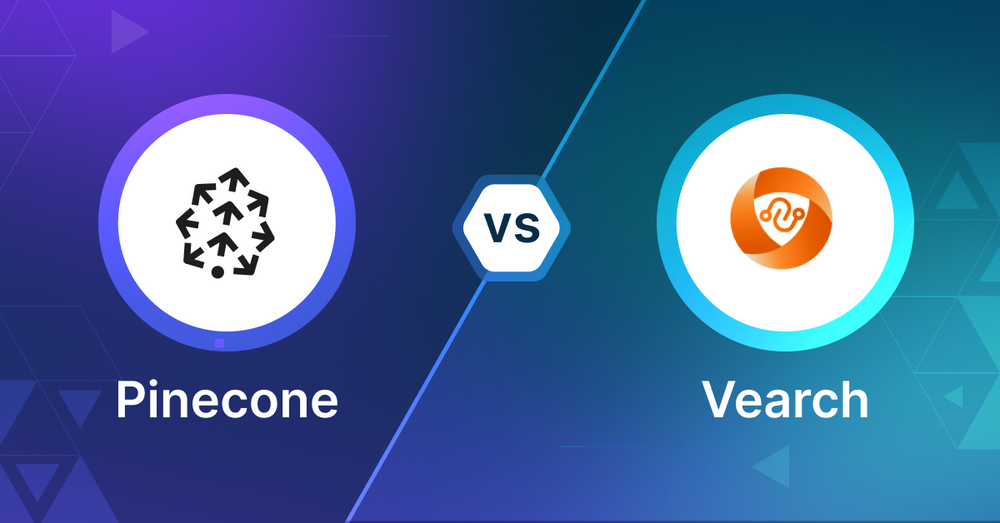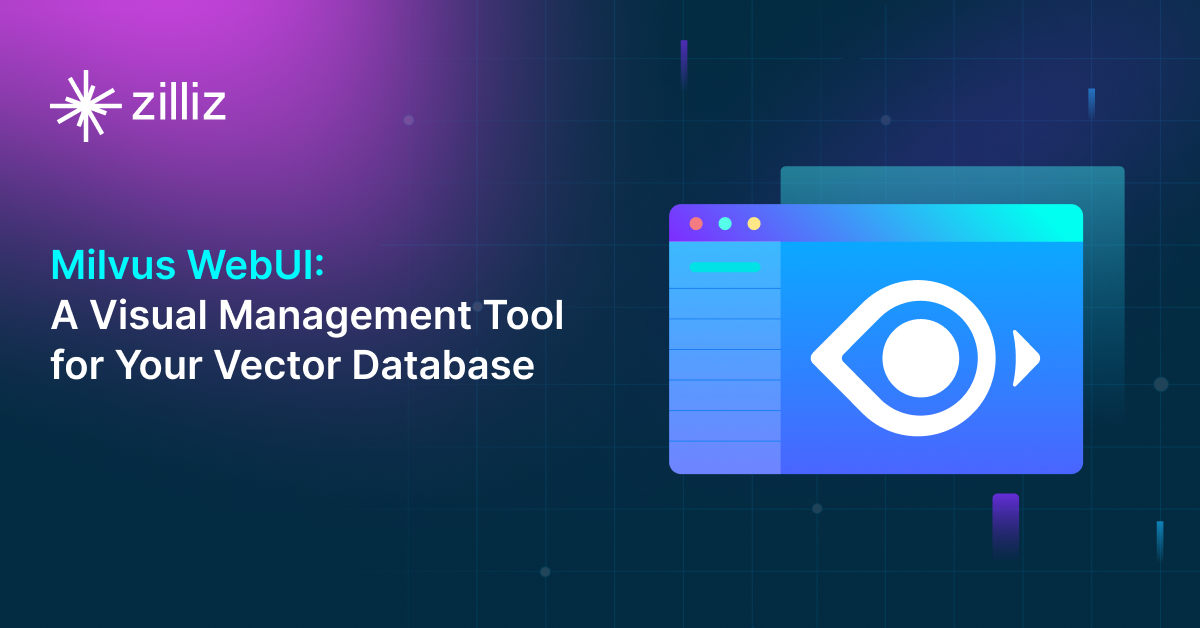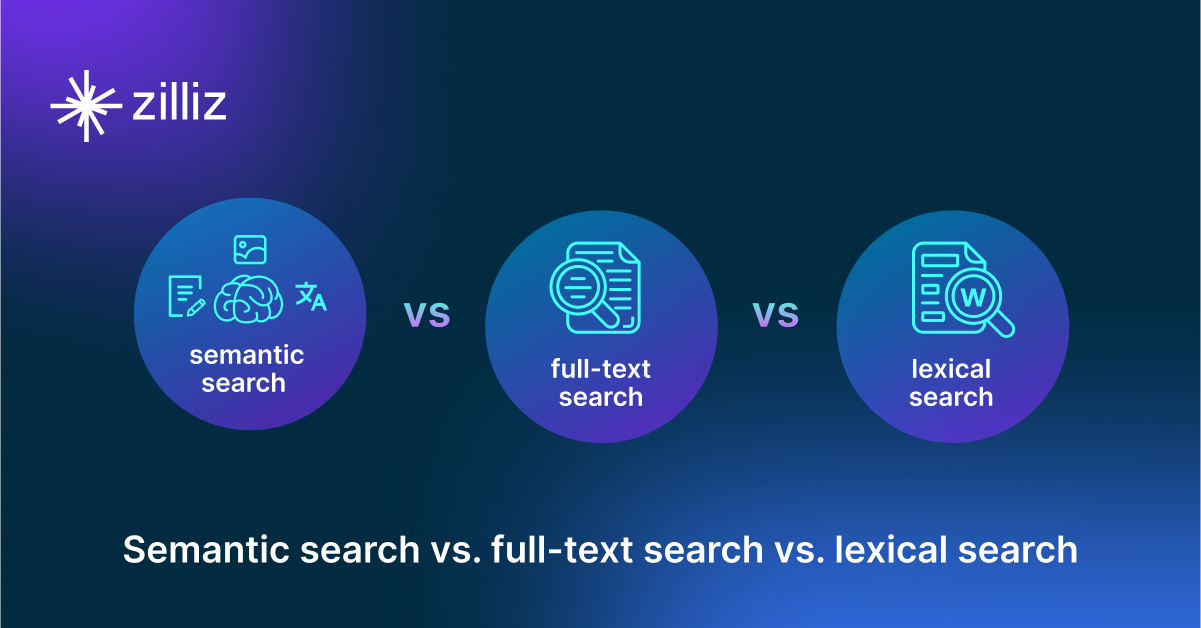Pinecone vs Vearch: Selecting the Right Database for GenAI Applications

As AI-driven applications evolve, the importance of vector search capabilities in supporting these advancements cannot be overstated. This blog post will discuss two prominent databases with vector search capabilities: Pinecone and Vearch. Each provides robust capabilities for handling vector search, an essential feature for applications such as recommendation engines, image retrieval, and semantic search. Our goal is to provide developers and engineers with a clear comparison, aiding in the decision of which database best aligns with their specific requirements.
What is a Vector Database?
Before we compare Pinecone vs Vearch, let's first explore the concept of vector databases.
A vector database is specifically designed to store and query high-dimensional vectors, which are numerical representations of unstructured data. These vectors encode complex information, such as the semantic meaning of text, the visual features of images, or product attributes. By enabling efficient similarity searches, vector databases play a pivotal role in AI applications, allowing for more advanced data analysis and retrieval.
Common use cases for vector databases include e-commerce product recommendations, content discovery platforms, anomaly detection in cybersecurity, medical image analysis, and natural language processing (NLP) tasks. They also play a crucial role in Retrieval Augmented Generation (RAG), a technique that enhances the performance of large language models (LLMs) by providing external knowledge to reduce issues like AI hallucinations.
There are many types of vector databases available in the market, including:
- Purpose-built vector databases such as Milvus, Zilliz Cloud (fully managed Milvus)
- Vector search libraries such as Faiss and Annoy.
- Lightweight vector databases such as Chroma and Milvus Lite.
- Traditional databases with vector search add-ons capable of performing small-scale vector searches.
Pinecone and Vearch are purpose-built vector databases. This post compares their vector search capabilities.
Pinecone: The Basics
Pinecone is a SaaS built for vector search in machine learning applications. As a managed service, Pinecone handles the infrastructure so you can focus on building applications not databases. It’s a scalable platform for storing and querying large amounts of vector embeddings for tasks like semantic search and recommendation systems.
Key features of Pinecone include real-time updates, machine learning model compatibility and a proprietary indexing technique that makes vector search fast even with billions of vectors. Namespaces allow you to divide records within an index for faster queries and multitenancy. Pinecone also supports metadata filtering, so you can add context to each record and filter search results for speed and relevance.
Pinecone’s serverless offering makes database management easy and includes efficient data ingestion methods. One of the features is the ability to import data from object storage, which is very cost effective for large scale data ingestion. This uses an asynchronous long running operation to import and index data stored as Parquet files.
To improve search Pinecone hosts the multilanguage-e5-large model for vector generation and has a two stage retrieval process with reranking using the bge-reranker-v2-m3 model. Pinecone also supports hybrid search which combines dense and sparse vector embeddings to balance semantic understanding with keyword matching. With integration into popular machine learning frameworks, multiple language support and auto scaling Pinecone is a complete solution for vector search in AI applications with both performance and ease of use.
What is Vearch? The Basic
Vearch is a tool for developers building AI applications that need fast and efficient similarity searches. It’s like a supercharged database, but instead of storing regular data, it’s built to handle those tricky vector embeddings that power a lot of modern AI tech.
One of the coolest things about Vearch is its hybrid search. You can search by vectors (think finding similar images or text) and also filter by regular data like numbers or text. So you can do complex searches like “find products like this one, but only in the electronics category and under $500”. It’s fast too - we’re talking searching on a corpus of millions of vectors in milliseconds.
Vearch is designed to grow with your needs. It uses a cluster setup, like a team of computers working together. You have different types of nodes (master, router and partition server) that handle different jobs, from managing metadata to storing and computing data. This allows Vearch to scale out and be reliable as your data grows. You can add more machines to handle more data or traffic without breaking a sweat.
For developers, Vearch has some nice features that make life easier. You can add data to your index in real-time so your search results are always up-to-date. It supports multiple vector fields in a single document which is handy for complex data. There’s also a Python SDK for quick development and testing. Vearch is flexible with indexing methods (IVFPQ and HNSW) and supports both CPU and GPU versions so you can optimise for your specific hardware and use case. Whether you’re building a recommendation system, similar image search or any AI app that needs fast similarity matching, Vearch gives you the tools to make it happen efficiently.
Key Differences
When choosing a vector search tool, you need to consider your use case and project requirements. Let’s compare Pinecone and Vearch to help you decide.
Search Methodology
Pinecone uses a custom indexing technique for fast search over billions of vectors. Supports real-time updates and 2 stage retrieval with reranking.
Vearch has flexible indexing methods, supports IVFPQ and HNSW algorithms. Supports hybrid search combining vector similarity with filtering.
Data
Pinecone is great for managing vector embeddings for semantic search and recommendation systems. Supports metadata filtering to add context to records.
Vearch handles vector embeddings well and allows multiple vector fields per document. Good for complex data structures and diverse AI applications.
Scalability and Performance
Pinecone is auto-scaling as a managed service. Designed to handle large datasets with fast query times.
Vearch has clustered architecture with different node types (master, router, partition server) to distribute workload and scale horizontally. This allows for performance as data grows.
Flexibility and Customization
Pinecone has namespaces to divide records within an index, for faster queries and multitenancy. Supports multiple machine learning models and frameworks.
Vearch has flexibility in indexing methods and supports both CPU and GPU versions. Can optimize based on hardware and use case.
Integration and Ecosystem
Pinecone integrates with popular machine learning frameworks and supports multiple languages.
Vearch has a Python SDK for quick development and testing. Works with multiple AI applications but smaller ecosystem than Pinecone.
Ease of Use
Pinecone as a managed service handles infrastructure for you, so it’s easier to set up and maintain. Supports serverless and efficient data ingestion.
Vearch requires more hands-on management of the cluster. While it has developer friendly features, it has a steeper learning curve than fully managed solutions.
Cost
Pinecone pricing is usage based as a SaaS product. Data ingestion is cost effective through object storage imports.
Vearch is open source, so can reduce direct costs but more investment in infrastructure and management.
Security
Pinecone as a managed service probably has built in security (encryption, access control) etc.
Vearch’s security is up to you.
When to Choose Each
Choose Pinecone when you want a fully managed vector search solution that scales. It’s for teams building AI applications who want to focus on development not infrastructure management. Pinecone shines when you need real-time updates, complex metadata filtering and integration with multiple machine learning models. It’s great for large scale semantic search, recommendation systems and applications that benefit from built in reranking and hybrid search.
Choose Vearch when you want more control over your vector search infrastructure and have the resources to manage it. It’s a good choice for projects that need flexibility in indexing methods and hardware optimization. Vearch is great for complex data structures with multiple vector fields per document. It’s good for applications that need fine tuned performance optimizations, like image similarity search or custom recommendation engines where you want to use both CPU and GPU.
Summary
Pinecone is great for ease of use, managed infrastructure and strong ML ecosystem integration. It has robust scalability and built in reranking and hybrid search. Vearch is great for deployment flexibility, indexing methods and hardware optimization. It’s an open source solution that’s highly customizable. Your choice between these should be guided by your use case, data complexity, scalability requirements and team expertise. Consider managed services vs infrastructure control, data structure complexity and long term scalability needs. Both have vector search capabilities but the best fit will depend on how you align their strengths with your project’s needs.
Read this to get an overview of Pinecone and Vearch but to evaluate these you need to evaluate based on your use case. One tool that can help with that is VectorDBBench, an open-source benchmarking tool for vector database comparison. In the end, thorough benchmarking with your own datasets and query patterns will be key to making a decision between these two powerful but different approaches to vector search in distributed database systems.
Using Open-source VectorDBBench to Evaluate and Compare Vector Databases on Your Own
VectorDBBench is an open-source benchmarking tool for users who need high-performance data storage and retrieval systems, especially vector databases. This tool allows users to test and compare different vector database systems like Milvus and Zilliz Cloud (the managed Milvus) using their own datasets and find the one that fits their use cases. With VectorDBBench, users can make decisions based on actual vector database performance rather than marketing claims or hearsay.
VectorDBBench is written in Python and licensed under the MIT open-source license, meaning anyone can freely use, modify, and distribute it. The tool is actively maintained by a community of developers committed to improving its features and performance.
Download VectorDBBench from its GitHub repository to reproduce our benchmark results or obtain performance results on your own datasets.
Take a quick look at the performance of mainstream vector databases on the VectorDBBench Leaderboard.
Read the following blogs to learn more about vector database evaluation.
Further Resources about VectorDB, GenAI, and ML
- What is a Vector Database?
- Pinecone: The Basics
- What is Vearch**? The Basic**
- Key Differences
- When to Choose Each
- Summary
- Using Open-source VectorDBBench to Evaluate and Compare Vector Databases on Your Own
- Further Resources about VectorDB, GenAI, and ML
Content
Start Free, Scale Easily
Try the fully-managed vector database built for your GenAI applications.
Try Zilliz Cloud for FreeKeep Reading

Milvus WebUI: A Visual Management Tool for Your Vector Database
Milvus WebUI is a built-in GUI introduced in Milvus v2.5 for system observability. WebUI comes pre-installed with your Milvus instance and offers immediate access to critical system metrics and management features.

Semantic Search vs. Lexical Search vs. Full-text Search
Lexical search offers exact term matching; full-text search allows for fuzzy matching; semantic search understands context and intent.

Vector Databases vs. NewSQL Databases
Use a vector database for AI-powered similarity search; use a NewSQL database for scalable transactional workloads requiring strong consistency and relational capabilities.
The Definitive Guide to Choosing a Vector Database
Overwhelmed by all the options? Learn key features to look for & how to evaluate with your own data. Choose with confidence.